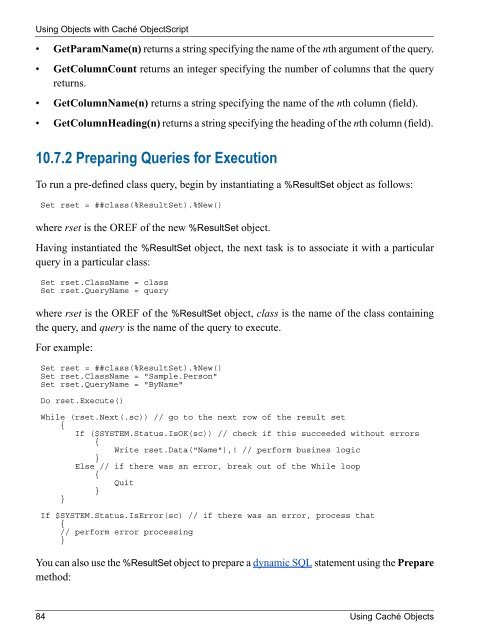Using Caché Objects - InterSystems Documentation
Using Caché Objects - InterSystems Documentation
Using Caché Objects - InterSystems Documentation
You also want an ePaper? Increase the reach of your titles
YUMPU automatically turns print PDFs into web optimized ePapers that Google loves.
<strong>Using</strong> <strong>Objects</strong> with <strong>Caché</strong> ObjectScript<br />
• GetParamName(n) returns a string specifying the name of the nth argument of the query.<br />
• GetColumnCount returns an integer specifying the number of columns that the query<br />
returns.<br />
• GetColumnName(n) returns a string specifying the name of the nth column (field).<br />
• GetColumnHeading(n) returns a string specifying the heading of the nth column (field).<br />
10.7.2 Preparing Queries for Execution<br />
To run a pre-defined class query, begin by instantiating a %ResultSet object as follows:<br />
Set rset = ##class(%ResultSet).%New()<br />
where rset is the OREF of the new %ResultSet object.<br />
Having instantiated the %ResultSet object, the next task is to associate it with a particular<br />
query in a particular class:<br />
Set rset.ClassName = class<br />
Set rset.QueryName = query<br />
where rset is the OREF of the %ResultSet object, class is the name of the class containing<br />
the query, and query is the name of the query to execute.<br />
For example:<br />
Set rset = ##class(%ResultSet).%New()<br />
Set rset.ClassName = "Sample.Person"<br />
Set rset.QueryName = "ByName"<br />
Do rset.Execute()<br />
While (rset.Next(.sc)) // go to the next row of the result set<br />
{<br />
If ($SYSTEM.Status.IsOK(sc)) // check if this succeeded without errors<br />
{<br />
Write rset.Data("Name"),! // perform busines logic<br />
}<br />
Else // if there was an error, break out of the While loop<br />
{<br />
Quit<br />
}<br />
}<br />
If $SYSTEM.Status.IsError(sc) // if there was an error, process that<br />
{<br />
// perform error processing<br />
}<br />
You can also use the %ResultSet object to prepare a dynamic SQL statement using the Prepare<br />
method:<br />
84 <strong>Using</strong> <strong>Caché</strong> <strong>Objects</strong>

















